Swinging Tandem Flies For Steelhead

By Louis Cahill
Most anglers successfully fish teams of flies for trout. Why not for their anadromous cousins?
I was introduced to this idea by a good friend who is one of the fishiest guys I know. When swinging traditional flies on a floating line he always fishes a team of two flies. He tells me he catches about a third of his fish on the top fly and he’s convinced that it boosts his overall numbers by that amount.
I almost never fish for trout with less than two flies so it’s easy for me to accept the idea that I should be doing it for steelhead. The idea behind tandem flies for swinging is a little different but the logic is compelling. But does it really work?
The Theory
My buddy explained it to me this way. When you are swinging a fly and a fish swirls on it without taking it, what would you do? You’d change flies and make the same cast, showing him another. Sometimes that fish will eat the second fly. My buddy’s idea is that we get looks and swirls all the time that we never see. I find that likely. He ties his second fly the length of his step above the first, so that as he steps he automatically puts two flies over each fish. That’s kind of brilliant.
So to be clear, it’s the fly at the end of the leader which the fish sees first and fly at the top which is seen second. The team functions a little differently than a team of trout flies. A team of trout flies gives the fish a more immediate choice of patterns or depths, covering a spread of what the fish might be keying on. The steelhead version offers the fish a second chance to take the fly, with time being the variable. This makes sense. Steelhead are not feeding so the take is an aggressive strike rather than a reaction to a chosen food type.
The Setup
First let’s be clear that we are talking about fishing a floating line in traditional summer steelhead fashion. This technique would be extremely difficult to pull off in a Skagit system with sinking tips.
Like any tandem setup there are several ways you could tie on your flies. For simplicity and function, I like the setup my buddy uses. I use an intermediate polyleader and at the end I attach a short piece of 15-pound Maxima and tie a loop at the end. I then use a loop-to-loop connection to attach my 12-pound maxima tippet. The lengths of leader and tippet vary depending on the line you are fishing and that’s another article.
Rather than tying the fly to this tippet
Read More »“Do It Yourself Bonefishing” by Rod Hamilton, Reviewed
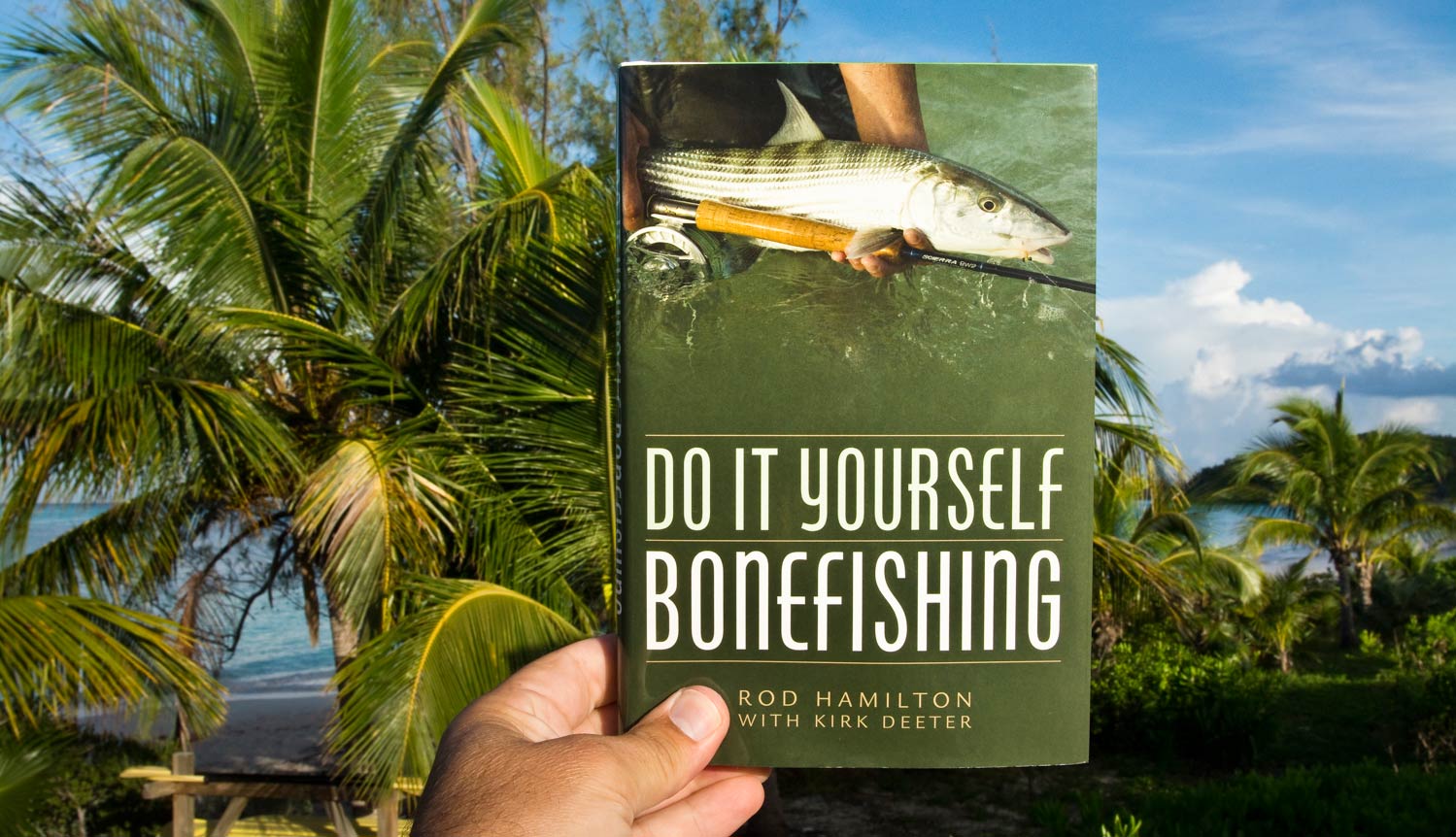
IT’S EVERY ANGLER’S DREAM TO CATCH BONEFISH ON THE FLATS BY THEMSELVES.
That may not be completely true, but if it sounds right to you, maybe you should pick up a copy of Rod Hamilton’s new book, “Do It Yourself Bonefishing.” It’s certainly a step in the right direction.
Rod, with the help of my good friend Kirk Deeter, has put together one of the most concise and easy to use volumes on the topic of flats fishing. This book covers it all and explains in clear terms how you can become a serious threat on the flats, without a guid or the expense of a lodge trip.
I’ll pause at this point to make my feelings clear. As I have said many times, if you are learning to bonefish there is no replacing the important role of a good guide who is willing to teach. There is also no better way to learn than the immersion you get from the lodge experience. That said, when you are ready to make the leap to bonefishing on your own, this book is a must.
The first half of the book covers the hows and whys of DIY bonefishing, including the equipment and skills you will need. Topics like how to spot bonefish, understanding tides and retrieving the fly are covered in great detail.
The second half of the book is a terrific resource
Read More »One Cast, Two Presentations
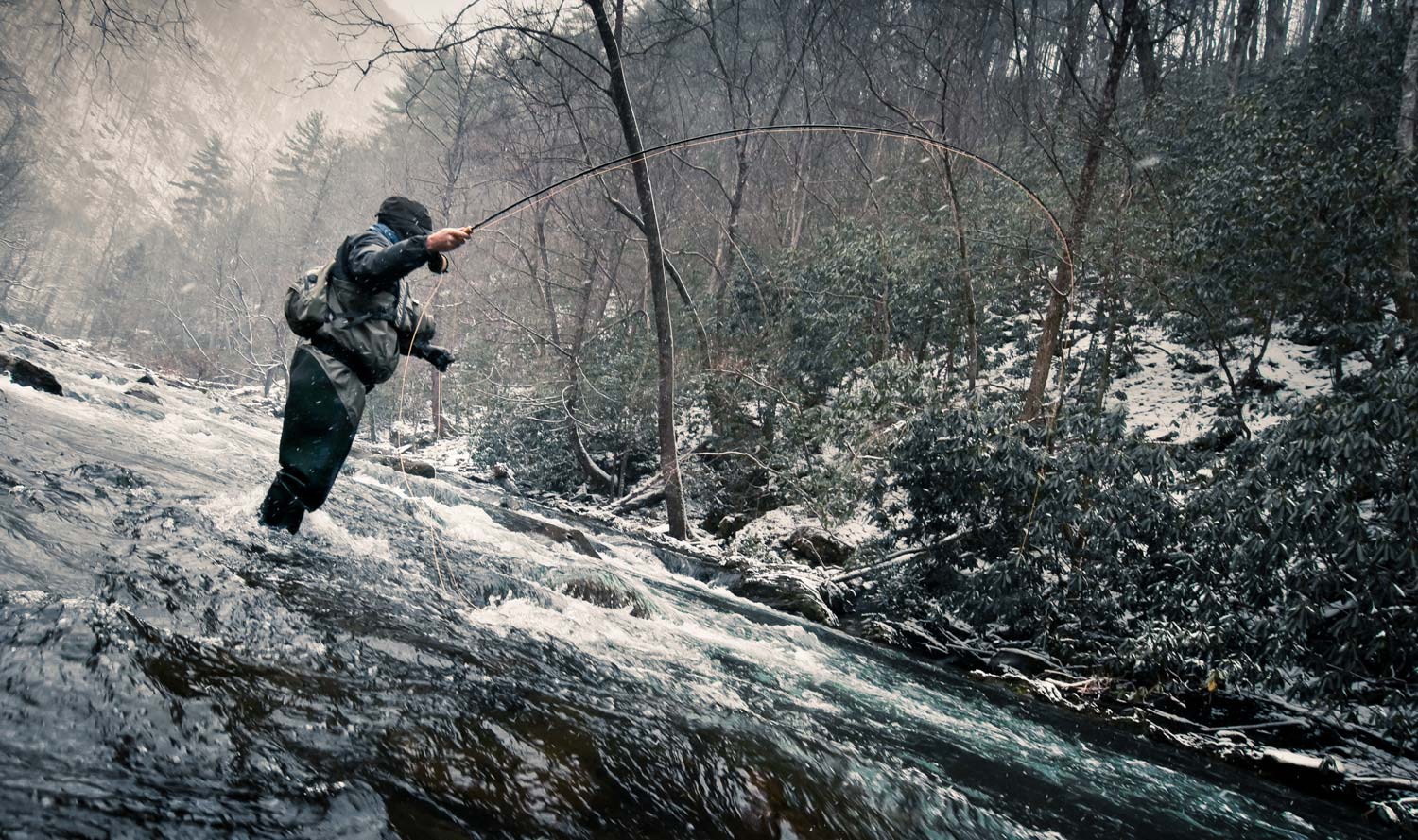
Each time you cast a fly, you’re actually making two presentations.
I had a conversation recently, with my buddy Bruce Chard, that got me thinking. Bruce is extremely precise when he talks about fly fishing and he religiously uses two terms I’ve only heard from very skilled anglers, and which I believe are not in the common lexicon of the sport. In spite of these terms being somewhat uncommon, after our conversation I agreed with Bruce that they hold real value to the average angler.
The terms are “primary presentation” and “secondary presentation.”
We very commonly speak of our presentation as the cast or delivery of the fly to the fish. We also refer to different types of presentations, like “dead drift” or “swing.” The terms primary and secondary presentation acknowledge that both the cast and the way we fish the fly are each a type of presentation. Whether we recognize it or not, each time we present the fly, both of those things are happening and each must be executed properly to catch a fish.
At first this struck me as a semantic argument, but after thinking about it, I believe the terms are helpful. Not only in letting us talk more specifically about our technique, but also in the way it forces us to think about it. I think our non-specific language serves as shorthand for skills we take for granted. Thinking of primary and secondary presentation as separate things helps us communicate finer points of presentation and helps us understand how the two work together.
For example, let’s say I am presenting the fly to a trout which is down and across stream from me.
Scenario one: I am fishing a dry fly. Primary presentation: I would drop the fly directly upstream of the fish, far enough to be
Read More »Forced Perspective In Fish Photos, What’s Right?
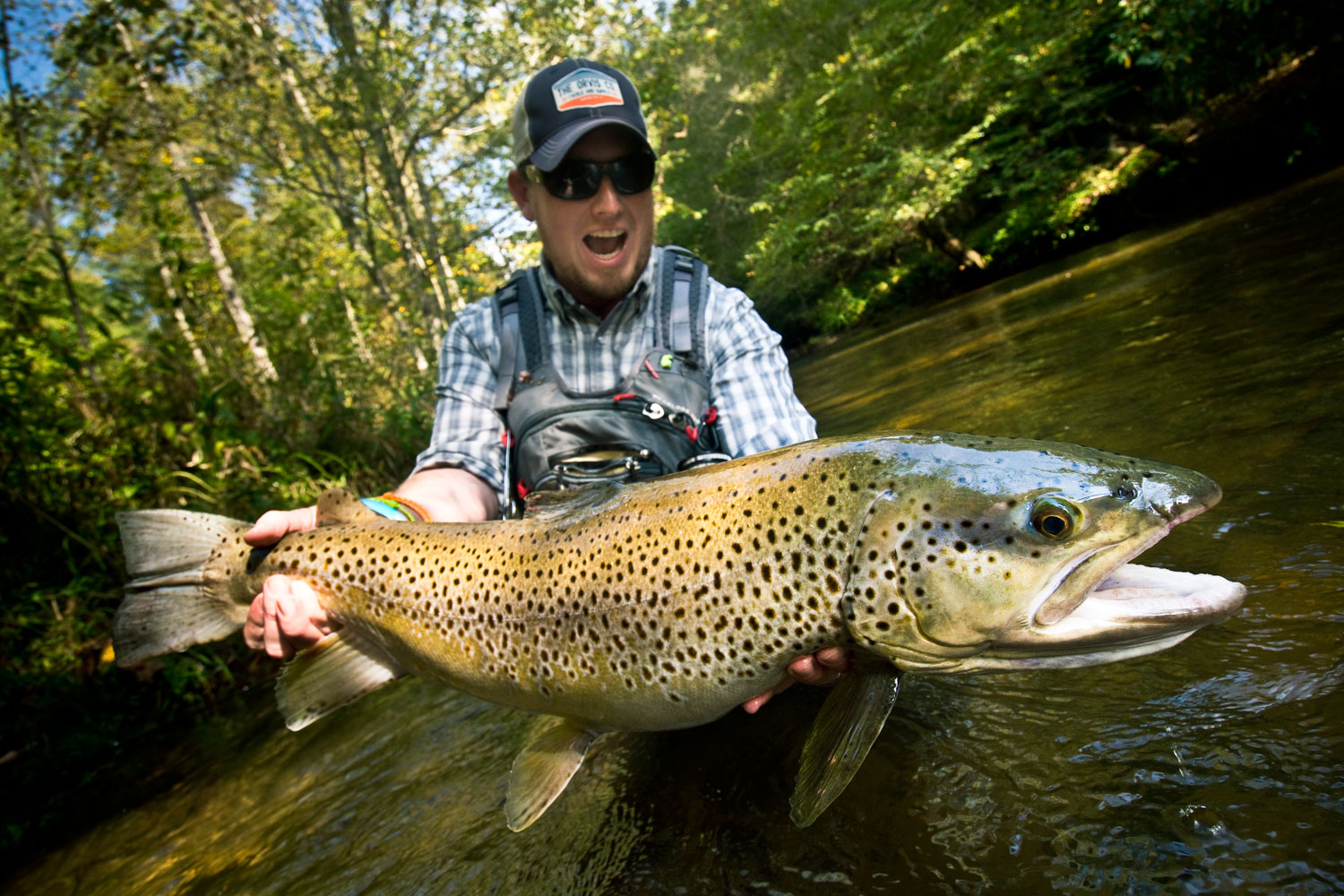
Is holding a fish up to the lens tantamount to Lying?
The other day I shared a photo of my good friend and G&G contributor Justin Pickett holding a huge brown trout with Orvis for use on their blog. The look on Justin’s face says it all. A fish like this could well be the fish of a lifetime. Since he landed it on an Orvis Helios 2, 4 weight, it seemed fitting that Orvis should share in the online glory.
Orvis shared the photo on their Facebook page and the comments lit up immediately. Lots of positive comments about what a great fish Justin had landed but a handful of trolls as well, claiming that the fish wasn’t big, just held out to the camera for forced perspective. Certainly, you’d expect that kind of juvenile behavior on Facebook, but it think it also says a lot about the fishing community.
Let’s get this out of the way. Justin had a tape in his pack and I measured the fish. It was 29 inches on the nose. I know Justin would have like it to be 30, fishermen are never satisfied, but I’d like to know where these trolls are fishing that a 29-inch brown trout isn’t big.
As a photographer who is in the business of photographing fish I think about this a lot. Pretty much every fish photo you see in the media is an example of forced perspective. It’s not at all unlike the photos you see in fashion magazines of rail thin super-models. If American women are having body image issues they should talk to the poor fish.
Just like in the fashion industry, the arguments about it aren’t going to change anything. You’re far more likely to see plus size models on the cover of Vogue next year than 9 inch trout held close to the chest on any fly fishing media. It’s frustrating to me for a couple of reasons. I’m much more interested in beautiful macro photos of colorful wild trout or creative images that capture the feeling of the moment, but nobody buys them. Trust me, I have hard drives full of them. Just like those Vogue photographers, I’m way more interested in paying my bills than arguing about whose fish is bigger.
I’m also frustrated that folks who know nothing about either the art or science of photography are instant experts on the Internet. Truth. What is that really? This topic of truth in photography got blown way out of proportion when digital cameras were invented. Suddenly publications like Time we’re making rules about how images could not be manipulated, AT ALL. Meaning no color correction or dust spots removed. The same things those same publication had been doing to every photo they printed for decades. All they accomplished was publishing a lot of bad photos.
The truth is that every photograph you have ever seen has been manipulated. Regardless of what you think is real or not real, a photograph is, by definition, a creative work. Someone made it and they imposed their idea of reality on it. It’s no different from a paining. If you are thinking that this isn’t true, it’s because you have had experience using some kind of automatic camera that someone has set up for you. It’s a black box, with a little artist inside. Just because you don’t understand it doesn’t make it truthful. Ask anyone who really understands how cameras work and they’ll tell you I’m right. The camera does lie. That’s all it’s ever done and I have made my living at it for over thirty years. In the end, the only reality is the one you make for yourself.
What I’m really interested in is not an existential debate on the nature of reality. The thing that gets under my skin about this is
Read More »Summer is Coming
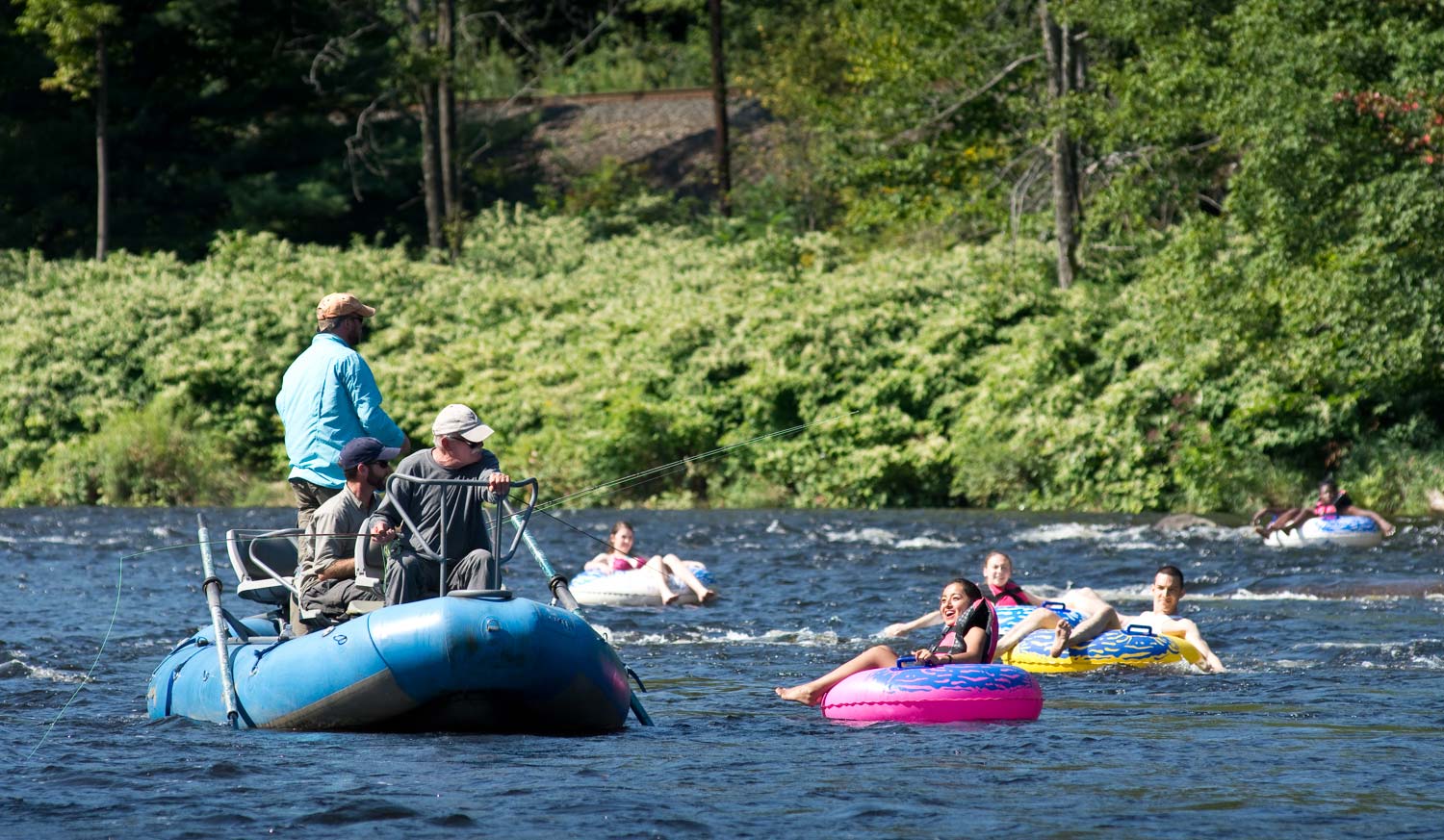
Summer, and the tube hatch, are just around the corner.
Here in the south we view summer in much the same way the my northern friends view winter. There’s plenty of fun outdoor stuff for us to do but it’s also a long miserable slog. It’s also a time many of us dial back our trout fishing and seek out other species, as water temperature climb dangerously high for man and trout.
Tom Dorsey, of Thomas and Thomas, doesn’t seem to mind. I love this photo of Tom, taking a moment to chat up the daily tube hatch. Nothing creepy going on here. Tom seemed oblivious, fishing off the other side of the boat, until this young lady paddled over and spoke to him.
I couldn’t hear the conversation, and I think it’s very unlikely that this gal knew she was talking with one of the greatest fly rod designers of all time. Secretly I like to think she was a fan who recognized Tom on the river and couldn’t resist paddling over for an introduction. That’s the world I’d like to live in, anyway.
Either way, it’s impossible to talk with Tom and
Read More »Streamer Tactics for Small Trout Water
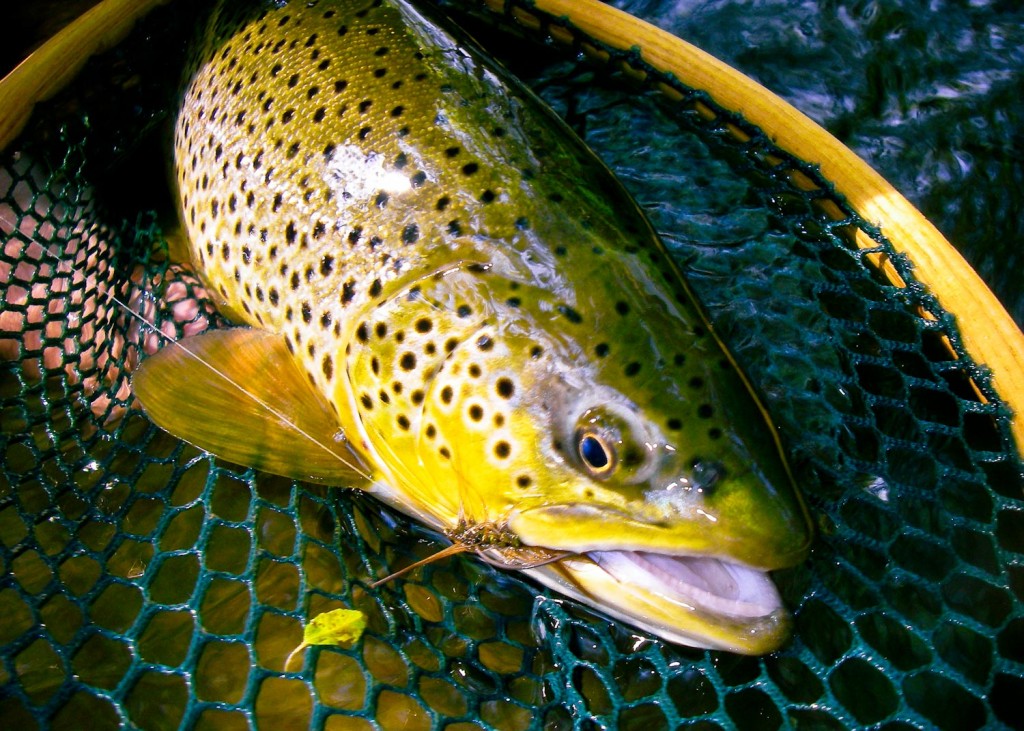
Successful Streamer Tactics for Small Trout Water.
Streamer fishing isn’t for everyone. I’ve known fly fisherman that would refuse to tie one on, even if you offered them a 20 dollar bill. But for those very few anglers that find fishing them repulsive, there’s plenty more of us out there that hold a deep love for streamers. It’s long been known by fly fisherman that streamers hold an uncanny ability to tempt the largest fish in our water. Streamers work on all types of trout water (rivers, streams and still-waters), but despite their wide range of effectiveness, most of the attention and information provided to fly fisherman in the past has been heavily skewed toward only promoting fishing them on our larger rivers and streams. To some degree, this favoritism has resulted in giving the impression to many beginner and intermediate fly fisherman that streamer fishing isn’t meant for small stream applications, and they should leave them at home. The truth is, that’s not the case at all. I’ve landed some of my largest trout on small streams with streamers when I couldn’t get them to eat a dry or wet fly.
It’s important for fly anglers to know they can have just as much success with streamers on small water as they can on larger water, and they shouldn’t overlook the opportunity to use them when conditions are right. Furthermore, if we lumped all of our trout water together in the region, the overwhelming majority of it would be considered small trout streams, creeks and high-elevation tributaries.
Small Stream Strategies for Streamers
The first thing you need to understand is that you need to fish streamers differently than you do on large trout water. Large water streamer fishing is all about making repetitive presentations and covering lots of high percentage trout water–you make considerably longer casts and stealth becomes less of a factor. On small trout water, stealth is huge and you don’t want to cover a high percentage of trout lies by carpet bombing it with a plethora of presentations. You’ll find it much more effective if you instead take a hunter’s approach that focuses on making a one-shot kill.
Start out by first locating where you think a large trout may be holding, approach the spot with a high degree of stealth, and lastly, strive to make a presentation that allows you to work your streamer through the highest percentage spots right off the bat. You want to accomplish this with as few casts as possible, preferably only one or two.
There’s no dissecting water with your streamers here, folks. We’re not trying to see how many fish we can catch out of each hole. Nor are we trying to cover every square-inch of water. The excitement that triggers a trout into chasing down or eating your streamer lasts only for a brief period. That’s why it’s so important that you take the time to pick and choose your first couple casts strategically. So always cast to the prime water first and the subpar or secondary water second. If you target the water in the opposite order, most of the time your fly will swim through the water out of the target fish’s feeding range, and you’ll greatly decrease your chances of surprising and triggering a reaction strike (your best case scenario for a hookup). You’ll also risk alerting and spooking the fish before you have a good shot at getting your fly in front of them.
Streamer Gear & Rigging for Small Streams
To be successful at streamer fishing, it’s critical that you choose the correct fly fishing gear for the type of water and location you’ll be fishing. Your fly rod, fly line and leader need to be handpicked so that they all work together. That being said, you can’t effectively streamer fish small streams with most of your big water gear. You don’t need a full sinking line or an eight or nine weight fly rod, and you don’t need to chuck giant streamers to catch trout either. If chosen incorrectly, it will keep you from fishing at your full potential, and you’ll find much less success.
Start out by choosing an eight to nigh-foot medium-fast action fly rod. I’m not talking about a stiff broomstick. We do want the rod to have some limberness so it can perform well at short casting distances, roll cast fairly well and allow us the ability to present the streamer reasonably quiet during a cast if needed. One of my favorite small stream streamer rods is a Thomas & Thomas Helix 9-foot 6wt. You’ll next want to choose a weight-forward floating fly line with an aggressive front taper that excels at turning over large and heavy flies (like a Rio Power Fly, SA Floating Streamer Express or Orvis Hydros Power Taper). So far, that’s relatively common sense for most, but I take it a step further by attaching an Airflo Poly 5-foot Leader (clear-floating or intermediate version) to the end of my fly line. It’s very similar to a smaller diameter version of your fly line that’s clear and turns over streamers effortlessly. By using a Poly Leader, you’ll find your loops won’t hinge and seldom will collapse from a heavy streamer at the end of your cast. I generally go with the clear intermediate version because its slow sink rate helps me to keep my fly a little deeper during the retrieve. However, I will use the floating version when I’m dealing with really low water conditions.
How many times have you had a trout follow your streamer to the boat and have it turn off at the last second because it spotted you? It’s happened to me plenty of times. On smaller streams we are constantly fighting to stay under the radar of fish. The smaller streams and shorter presentations put us close to the fish, and our bright fly line even closer. Plain and simple, the Airflo clear floating and intermediate Poly Leaders provide me with a little bit of extra stealth during my presentations when fishing streamers on small trout water.
The last component in my small trout water streamer rig is my tippet. I generally attach a short three to six foot section of fluorocarbon tippet (4x-2x) to the end of my poly leader and tie on my streamer with a non-slip loop knot. I’ve been using this setup for the last few years with great success. It casts way more graceful than your standard WF fly line and tapered leader setup, improves accuracy, helps keep my streamer in the correct depth and improves my overall stealth.
9 Tips for streamer fishing on small streams
Don’t make the mistake of thinking the larger or heavier the fly, the harder you need to cast your fly rod. Focus on timing and smooth
So Much More Than Brook Trout
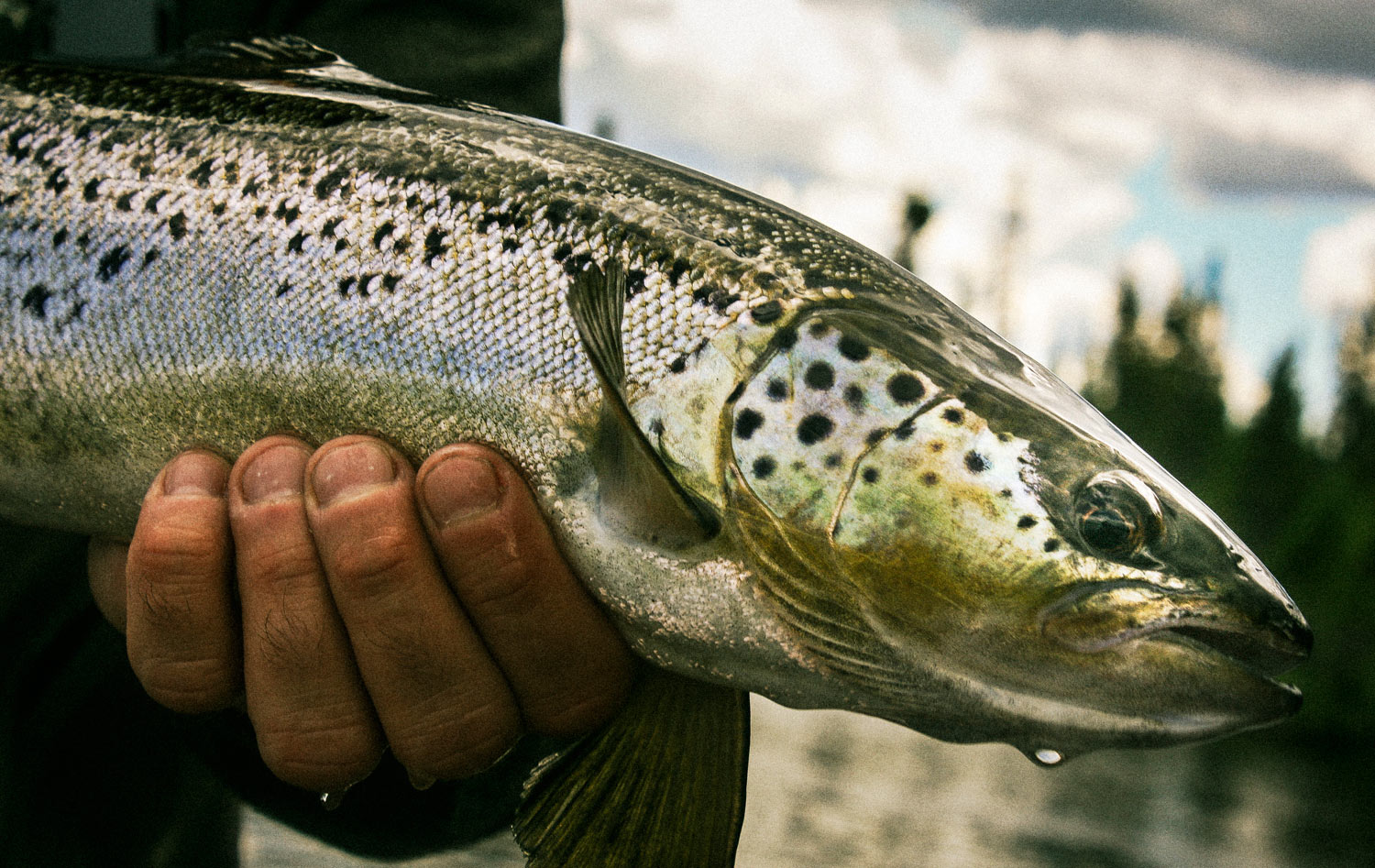
By Jason Tucker
TWILIGHT. THE SUN, SETTING UNDER CLEAR SKIES HAS TURNED EVERYTHING INTO BLUE MERCURY.
We have parked the boat on a gravel bar where ripping current meets still water. Fish are rising on the soft side of the seam that trails off the tip of the bar. We are so far north that dusk will last for hours. We are fishing in Labrador with Riverkeep Lodge on the Atikonak River.
Dave is after one large fish that keeps working the seam, rising repeatedly about sixty feet out. It’s too far to cast, but they’re taking skated caddis anyway, and so he has dumped a bunch of line, hoping to reach the fish, or get it to hit his Goddard caddis as he retrieves it back up the seam, a tactic that has worked numerous times.
Suddenly the fish rises forty feet away on the right side of the boat. Realizing that Dave doesn’t have time to pick up all that line and cast across the boat in time, I fire a quick cast to the rise form. The fish turns on a dime, and comes up on the surface as I throw a mend to twitch the fly. The fish rises with head, back, dorsal and tail fins all breaking the surface and it closes on my fly, mouth open, like a submarine on the surface. It takes an eternity for my fly to disappear and the mouth to close, but when I finally set the hook, the fish rolls and sounds, swims straight at us, and as I frantically strip line it jumps clear out of the water a few feet away at chest height. I find myself staring it in the eye, like some Warner Brothers cartoon character come to chastise me. Then it takes off on a blazing run that takes most of my fly line with it. It weighed over five pounds
And that was just one evening at Riverkeep Lodge. Don’t worry about Dave, he caught plenty of fish.
As long as I can remember I have been reading about Labrador and its legendary brook trout. As brook trout became an increasing obsession of mine, it became a lifelong dream to go. So when I got an invitation to go to Riverkeep Lodge with Dave Karczynski, it was impossible for me to say no.
We decided to make a road trip out of it, and when the time came I left my home in Northeast Georgia, drove to Ann Arbor, Michigan to pick up Dave, then we turned it east for the long trek across Ontario and Quebec. The drive itself was quite memorable, especially the long bush road from Baie Comeau to Labrador City, about 375 miles of gravel, pavement, and road construction with one gas station in the middle and not much else in the way of civilization. That story will have to wait for later.
The next day we took a float plane 120 miles into the Labrador bush to fish with Riverkeep Lodge on the Atikonak River. It is run by the Murray family, and their guides Keir and Eric were waiting for us, ready to show off what they have up there. Here’s what we found.
Read More »Three Ways We Lose Fish

by Jason Tucker
DUSK FALLS SLOWLY ON A JUNE SUMMER EVENING.
Zach and I stood knee deep in the tannic flowing water of a Northern Michigan stream, the calls of the day birds urgent as they headed to bed, before the night birds emerged. We waited, the sky impossibly bright despite the late hour, as the mosquitoes whined in our ears. In the last of the Boreal light the first Hexagenia of the evening emerged. Still we waited.
A few minutes later 3 large brown trout began feeding just upstream from us. They were over two hundred feet away, and just when we start to move upstream to meet them, a small fish fed thirty feet above us.
“Let me feed him some Hex” I said to Zach, tossing a cast up, more a joke than a serious attempt at fishing. My fly landed, and was pulled down immediately in a great sucking gulp.
I set the hook and without hesitation the fish ran upstream and took half my fly line. It paused for a moment, gave three or four great shakes of its head and ran again upstream, taking the rest of my line and forty feet of backing with it.
I looked at Zach in the gloam and said “It looks like we have to go after this one”, lunging forward in the dark water. Even as I did, the fish took off once more and my leader parted. I stood there breathless and stunned. It had all happened so fast.
I was fishing my eight weight rod with a straight twelve pound leader.
There are a lot of reasons we lose fish, and we all have stories of that one that got away. Personally I’d like to have fewer of these incidents, though they do add a certain something to campfire storytelling sessions. I’ve been party to a lot of big fish being landed or lost over the years. Every year, I find I’m kicking myself over some stupid mistake I’ve made that results in the old Long Distance Release. While entire books could be written on the subject, I will focus on three of the most common causes of losing good fish.
Bringing a Knife to a Gun Fight
Very often we either stick to fishing our favorite gear, or we gauge our gear to catching small or average fish. That 3 weight is just fine on most brook trout streams until a big brown comes rolling out from under a log and crushes your fly, and then the battle is on, and frequently lost. Heavier gear is called for if you suspect you have a chance at bigger fish. A 5 weight may work just fine during the day on your favorite stream; late at night when much bigger fish come out you may need to go up to a six weight or heavier. There was a reason I was fishing an eight weight in that opening story, because we had been hooking and catching fish well over twenty inches. I’ll never know how big that fish was, but that night my eight weight felt under powered.
The same can go for your tippet size. My good friend Tom, an excellent angler and caster, told me a couple of years ago that he quit fishing tippet smaller than 4X. He was tired of breaking fish off on 5X. His reasoning was what good does it do to hook up on a fish if the tippet doesn’t survive the hookset or the fish? All you’ve done is needlessly lost a fly without accomplishing anything. Since that conversation I’ve started using heavier tippet and losing fewer fish.
If you’re after big fish at night don’t hold back. I don’t use anything less than 8 pound tippet at night and often go up to 12 pound. You can also shorten your tippet considerably at night.
You Aren’t Mentally Prepared
This is one of the most common mistakes I see– we hook up on a big fish unexpectedly and lose our shit. Never mind
Snow Day
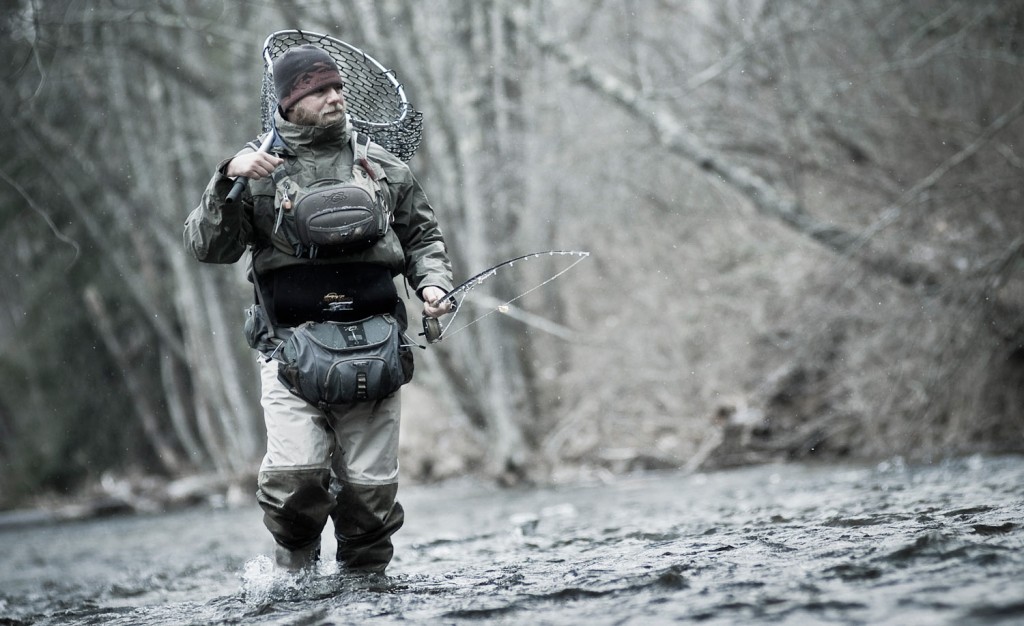
By Louis Cahill This story originally appeared in Fly Fusion Magazine Ice in my beard, fingers burning, I haven’t felt my feet for hours. I know from experience that it will be sometime around midnight, standing in my shower with the hot water running out, before I feel them again. My fingers are killing me, so I tuck my rod under my arm and work them into the fleece gator pulled up around my face. I’m a firm believer in global warming, but it’s a hard sell today. I have fished on some truly brutal days. Alaska in the fall, Maine at ice out in the spring. I fished in Colorado one day when it was ten below and I could watch the ice form around my boot freeze when I lifted it out of the water, but this day on the Nantahala river in the mountains of North Carolina may be the worst. You may scoff at this if you live somewhere like Wyoming or Michigan but if you’ve been here and seen it you know, when cold comes south, it comes holding a grudge. It’s about fifteen degrees at the truck. It feels colder on the water. The wind is howling and the snow has tapered off to flurries but what cuts right through the seven or eight layers I’m wearing is the humidity. It’s so humid that icicles form, right out of the air, on every surface that doesn’t have a constant source of heat. They hang grimly off of rods, and tree limbs, forceps and drying patches. I like days like this. I know that sounds crazy but any of the guys I fish with will tell you, the more miserable it is, the more I want to get at it. One reason is nobody else wants … Continue reading
Read More »Tenkara Presentation, Really “Fishing” The Fly

By Tim Harris
One fly, but many ways to fish it.
In a play of words, it is said that “tenkara” means “ten colors” since the kanji is the same – テンカ ラ. This means ten tenkara fishers have ten different styles of fishing. This could be that they use ten different flies or that they fish ten different techniques. Either way, tenkara is more about presentation and confidence in the fly than it is about the actual fly used, sort of like steelhead fishing.
Last season, and this season so far, I have used one fly only but have employed different techniques to catch fish in different conditions. I believe these techniques are not only applicable to tenkara but also to standard western fly fishing in small streams where you can probably present any fly with the right technique and get fish to eat.
HERE ARE SOME OF THE BASIC TECHNIQUES THAT I’VE INCORPORATED OVER THE THE LAST YEARS TO CATCH TROUT CONSISTENTLY WITH TENKARA.
1) Dead Drift – This one is easy enough and is the standard nymphing or dry fly technique common in western fly fishing and is usually how I start any given stretch of water. Tenkara has the advantage over a standard fly rod in that you can get a true drag-free dead drift since often no line is on the water, which must be mended, only the fly and tippet are in the current. Cast upstream or quartering upstream of a trout or potential trout holding location, keeping the line off the water as much as possible. As the fly drifts downstream, slowly lift the rod to keep contact with the fly and keep the fly drifting naturally. This can be done with the fly in the water or on the surface, depending on the type of pattern you are using. If you stick with one fly, like I do, you can dry out and dress or put on a fresh kebari to keep it on the surface if there is a rising trout you are going after.
2) Pulsing the Fly – This is one of my favorite techniques and goes against all convention of western fly fishing where the dead drift rules. Yet how often is a bug just tumbling with the current. Often they may be struggling to swim or move within that current, and this is where pulsing comes into play. Cast quartering upstream again, but this time
Read More »